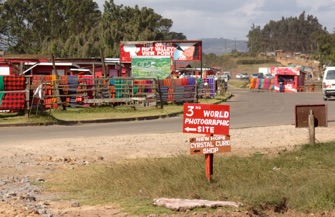kenyaView







Souvenirs 1/8
Since we travelled to Kenya as tourists, we bought some souvenirs while we were there. We bought a few things in the Maasai village we visited, we bought some wood bookends in a rest stop area for tourists, and we bought some Kenyan cotton t-shirts in an upmarket souvenir shop and restaurant in Nairobi on the way to the airport on our way back. We also bought some coffee and tea, and some delicious acacia honey.
In the area we travelled in, the most common souvenirs are bead jewelry and textiles of the type worn by the Maasai people. Unfortunately, these are not really things that we can use easily. The jewelry doesn't really suit the colours worn by adult women in our culture, and the textiles are rather gaudy for use, although both might go well on teenagers. The jewelry on sale for tourists also seems rather flimsy. The carvings in the Maasai village were not very well done, but we liked some of them. Surprisingly, the objects on sale in the souvenir shops in the up-market lodges were also of low quality and skill, at least for the price asked. The high-class souvenir market building in Nairobi had quite a lot of good things, but unfortunately we had only 30 minutes which was not enough to look closely.
If I were advising the souvenir sellers, especially the Maasai, I would say that they would make more money from their souvenirs if they were to produce at a higher quality and aim for higher prices. A bit of market research would be useful to them. We would have paid quite a lot of money for one really good quality carving or other item, but we didn't see anything suitable.

Souvenir stalls at a Rift Valley viewpoint
The roadside souvenir sellers and the Maasai village sellers insist on bargaining. They suggest truly ridiculous prices at the beginning, thinking, perhaps correctly, that they will get higher final prices that way. Some rich people seem to get a kick out of beating a poor seller down by as much as possible, anyway by at least ¢50 or $1, but we don't. Therefore, we would have bought more if the initially suggested prices were more sensible, or indeed in fixed price shops, because we tried to avoid bargaining. So for the things we actually bought, we often paid well beyond a sensible value, but we bought a lot less than we might have otherwise, or if we had had time to browse without a hard sell.